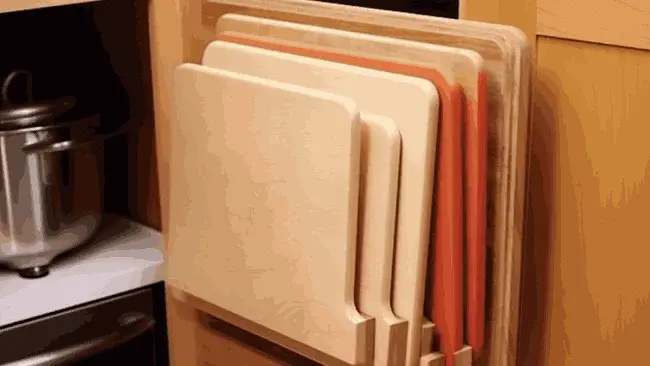Cutting boards are indispensable kitchen tools that every cook must have. They are used for chopping, dicing, and slicing ingredients, essential for everyday cooking. However, storing these cutting boards can be a hassle, especially if you have limited space in your kitchen.
Organize your cutting boards in a woven basket or install a wall-mounted board rack with hooks or slots to hang them. Consider showcasing your cutting and chopping boards on the countertop for quick and effortless access. Also, you can unleash your DIY talents by crafting a wooden cutting board holder.
We will explore different storage solutions for cutting boards, ranging from pre-made hanging wall racks to DIY wooden cutting board holders. By the end of this article, you’ll have multiple options that will work best for you, depending on your kitchen’s layout and size.
Jump to Section
Where to Store Cutting Board in a Kitchen: Unique and Effective Ideas

If you are looking for unique and effective ideas on how to store your cutting board, consider the following strategies:
1. Basket Storage
If you’re wondering where to keep your cutting board in a kitchen, consider basket storage a convenient solution. Placing your cutting boards inside a woven basket keeps them organized and adds a Scandinavian charm to your kitchen decor.
It’s a practical and stylish way to keep your cutting boards easily accessible. You can situate the basket in a less frequented corner to ensure it doesn’t interfere with foot traffic.
2. Pre-Made Hanging Wall Rack
Installing a pre-made wall-mounted rack with hooks or slots is a practical solution that saves valuable counter and cabinet space. Not only does it provide a convenient place to store your cutting board, but it also adds a decorative element to your kitchen.
By hanging your cutting board on the wall, you can easily access it whenever you need it without cluttering up your workspace. The rack keeps your cutting board accessible while keeping it out of the way when not in use.
Also, you can maximize your kitchen space by crafting a DIY wooden cutting board holder and utilizing a wall-mounted rack or hooks for easy and stylish storage.
This solution is especially useful in compact kitchens where countertop space is limited. You can free up valuable counter space for other kitchen tasks by utilizing vertical wall space.
3. Pegboard Wall Storage
Installing a pegboard on a kitchen wall lets you hang your cutting board using hooks or specially designed pegs. This saves valuable counter space and adds a visually interesting element to your kitchen decor.
The pegboard provides a versatile storage option, allowing you to adjust the hooks or pegs according to the size and shape of your cutting board. This way, you can keep your cutting board within reach while keeping it organized and out of the way.
Also, the pegboard wall storage allows easy access and reduces the risk of your cutting board getting damaged or scratched.
4. Vertical Slot Organizer
Store your cutting board in a vertical slot organizer for a space-saving and convenient storage solution in your kitchen. You can easily slide your cutting boards into the slots by installing a vertical slot organizer inside a cabinet door or the wall.
With a vertical slot organizer, you no longer have to search cabinets or rummage through drawers to find the right cutting board. Instead, they’re neatly stored and easily accessible whenever you need them.
5. In a Drawer with Organizer
You can keep your cutting board organized by placing it in a drawer with an organizer, ensuring easy access and efficient storage. This setup saves valuable cabinet space and keeps all your cutting boards in one place.
With a dedicated drawer, the boards won’t slide around or take up precious countertop space. Also, storing the cutting board in a drawer protects it from potential damage and prolongs its lifespan.
6. Tilt-Out Cutting Board Cabinet
When remodeling your kitchen, consider incorporating a tilt-out cutting board cabinet. It provides a unique and effective solution for storing your cutting boards.

This cabinet has a hinged front panel that reveals slots for your cutting boards when opened. It allows you to keep your cutting boards neatly organized and easily accessible. No more digging through drawers or cluttering up your countertops.
The tilt-out design also saves space, making it ideal for smaller kitchens. It adds a sleek and modern touch to your kitchen decor. You can choose from different materials and finishes to match your kitchen style.
7. Countertop Display
Consider using a plate stand to create a sleek, organized countertop display for your cutting boards. Storing your boards vertically on a plate stand saves space and allows them to air dry properly.
These kitchen organization aids are designed to hold your boards securely and prevent them from sliding or falling over. By displaying your cutting boards on the countertop, you can have quick and effortless access whenever you need them. It adds a stylish touch to your kitchen decor.
8. Under-Cabinet Pull-Out Rack
Store your cutting boards conveniently under your cabinets with an under-cabinet pull-out rack, allowing easy access while keeping them hidden.
This space-saving vertical solution is perfect for kitchens with limited countertop space. The pull-out rack is designed to hold multiple cutting boards of various sizes, keeping them organized and within reach.
Installation is quick and easy, requiring only a few screws to attach the rack to the bottom of your cabinets. Once installed, simply slide the rack out to retrieve a cutting board and push it back in when you’re done.
No more cluttered countertops or searching through cabinets for a cutting board. With this cabinet pull-out rack, you can keep your cutting boards neatly stored and easily accessible.
9. Roll-Out Tray
By installing a roll-out tray in a lower cabinet, similar to a pull-out trash bin, you can store your cutting boards vertically, allowing easy access and visibility. There’s no more digging through cluttered cabinets or struggling to find the right board when needed.
With a roll-out tray, you can pull it out, select the cutting board you want, and slide it back in when you’re done. It’s a practical and efficient way to store your cutting boards, making your cooking experience more enjoyable and hassle-free.
10. Sliding Cabinet Door
You can easily access your cutting board by sliding the cabinet door to reveal a designated space for storage. This sliding cabinet door is a great solution for keeping your cutting board within reach while adding a stylish touch to your kitchen.
The door can be designed in a sliding barn style, giving your kitchen a rustic and charming look. Behind the sliding door, you can have hooks or designated slots to hang or place your cutting boards.
11. Over-the-Sink Cutting Board
Consider using an over-the-sink cutting board to maximize counter space and make meal prep easier. This type of cutting board is designed to fit over your sink, allowing you to utilize the space effectively.
You can simply store it on a ledge above the sink when not in use, freeing up valuable counter space. This is especially useful in smaller kitchens where counter space is limited.
The over-the-sink design also makes washing and draining fruits, vegetables, and other ingredients convenient. You can easily slide the chopped ingredients into the sink for a quick clean-up. Also, many over-the-sink cutting boards come with built-in colanders or strainers, further simplifying the prep and clean-up process.
FAQ’s: Where to Store Cutting Board in a Kitchen
How should a cutting board be kept in place?
Keep the cutting board in a convenient and easily accessible location, such as a countertop or a designated cabinet, so you can quickly grab it whenever needed.

Use a slightly damp paper towel under your cutting board to keep it from sliding while you chop. Thinner towels work best because they won’t raise your cutting board and are less likely to create an uneven work surface.
This simple trick can help prevent accidents and make your chopping experience smoother. When choosing a towel, ensure it’s only slightly damp, as too much moisture can cause the board to slide even more.
Why should cutting boards be stored vertically?
Store your cutting board vertically to prevent moisture buildup and maintain cleanliness. Storing your cutting board vertically is important because it allows air to circulate, preventing moisture from getting trapped.
When moisture accumulates on a cutting board, it creates a breeding ground for bacteria and mold, causing food to become contaminated.
Why is it important to regularly inspect cutting boards?
To maintain food safety, you should regularly inspect your cutting boards for deep grooves and gauges, and if found, replace them promptly.
Deep grooves and gauges in cutting boards can harbor bacteria, even if you clean them with soap. It’s important to remember that bacteria can hide in these crevices, making it difficult to sanitize the cutting board fully.
What is the most sanitary type of cutting board?
If you’re wondering what the most sanitary cutting board is, consider using a bamboo cutting board due to its resistance to bacteria.
Bamboo cutting boards are harder and less porous than hardwoods, making them less likely to absorb moisture and harbor bacteria. They also resist scarring from knives, further reducing the possibility of bacterial growth.
Clean your bamboo cutting board thoroughly after each use with hot, soapy water and a brush to keep your bamboo cutting board sanitary. Also, you should avoid leaving moisture on the board for long periods and allow it to fully dry before storing it.
Conclusion
Storing your cutting board in a vertical position not only makes it more convenient, but it also helps maintain its cleanliness and longevity. Keeping it upright ensures that any moisture or food debris can easily drain away, reducing the risk of bacterial growth.
From basket storage to a roll-out tray, there’s no shortage of options for organizing your cutting boards. Remember to pick a storage solution that fits your kitchen’s layout and available space.
Also, regularly inspecting and replacing old and worn-out cutting boards is essential for maintaining a hygienic kitchen environment. Overall, choosing the right type of cutting board and storing it correctly are key factors in promoting kitchen safety and cleanliness.



![How to Store Tongs Safely in the Kitchen Drawer: 5 Steps [DIY]](https://tidytango.com/wp-content/uploads/2023/10/How-to-Store-Tongs-Safely-in-the-Kitchen-Drawer-5-Steps-DIY-480x252.webp)

![How Should a Whisk Be Stored: 4 Steps [Improve Longevity]](https://tidytango.com/wp-content/uploads/2023/10/How-Should-a-Whisk-Be-Stored-4-Steps-Improve-Longevity-480x252.webp)